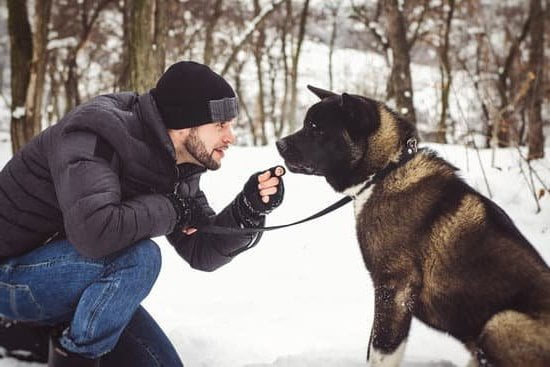Training your dog to come back inside is an essential skill that every pet owner should prioritize. Whether it’s for safety reasons or simply convenience, having a dog with a reliable recall command can make all the difference in your daily life. In this article, we will explore the significance of recall training, discuss the necessary preparations for effective training, and provide a step-by-step guide to teaching your dog the basic recall command.
Understanding why recall training is crucial is the first step towards successful training. Not only does a reliable recall help prevent accidents and keep your dog safe from potential dangers outside, but it also allows you and your furry friend to enjoy more freedom during off-leash walks or visits to parks.
Moreover, teaching your dog to come back inside can be lifesaving in emergency situations. We will delve into the benefits of a strong recall in various scenarios and highlight its importance in ensuring your dog’s well-being.
Before embarking on any training journey, it is crucial to prepare yourself mentally and emotionally for the challenges ahead. Setting realistic expectations is key as not all dogs learn at the same pace. Understanding your dog’s temperament and motivations will help tailor your training methods accordingly. Building a strong bond with your canine companion through positive reinforcement techniques will foster trust and enhance their motivation to listen and respond when called upon.
In the following sections, we will dive deeper into choosing the most effective training techniques, providing you with a clear roadmap for successful recall training. We will also address common challenges that may arise along the way and offer troubleshooting tips specific to stubborn dogs, fearful or anxious pets, distracted canines, as well as various age groups or breeds.
By following this comprehensive guide, you will acquire not only the skills necessary to teach your dog how to come back inside but also gain insights into advanced recall training techniques such as off-leash training and emergency recall cues. The joy of celebrating success and enjoying the benefits of a well-trained dog who comes back inside reliably awaits you on this rewarding journey.
So let’s get started and develop a strong bond with your furry friend through effective recall training.
Understanding the Importance of Recall Training
Recall training is one of the most essential skills you can teach your dog. Not only does it promote their safety and well-being, but it also allows for more freedom and enjoyment in different settings.
One significant reason why recall training is crucial is for the safety of your dog. Whether you’re at home or out on an adventure, there may be instances where your dog needs to come back to you quickly.
It could be to prevent them from approaching dangerous or harmful objects, avoiding potential hazards like traffic or strangers, or simply bringing them inside when it’s time to go. By teaching your dog a reliable recall command, you have better control over their movements and can keep them safe from potentially harmful situations.
A reliable recall also has several benefits beyond just safety. For instance, having a strong recall command allows your dog to enjoy off-leash walks and explore their surroundings more freely. It promotes mental stimulation and physical exercise while still giving you peace of mind that they will come back when called. Additionally, being able to call your dog back effectively enhances your bond with them by reinforcing trust and communication.
Recall training is essential in various scenarios as well. Emergency situations can arise unexpectedly, such as if your dog accidentally escapes through an open gate or encounters something frightening during a walk.
Having a well-trained recall command will help you quickly bring them back to safety in such situations. Furthermore, teaching your dog to come back reliably during outings to parks, beaches, or other public spaces ensures that they remain under control and don’t disturb others or endanger wildlife.
Overall, understanding the importance of recall training provides a solid foundation for successful training and sets the stage for future sections on preparing yourself for effective recall training and choosing the right training techniques. By recognizing why recall training is crucial for your dog’s safety, freedom, and well-being, you can approach the training process with the right mindset and motivation.
Preparing Yourself for Effective Recall Training
Before you begin training your dog to come back inside, it is important to prepare yourself for the process. This section will provide you with some key considerations and tips to help ensure that you are ready to effectively train your dog to come when called.
Firstly, it is important to set realistic expectations for recall training. Dogs learn at different rates, so be patient and understanding throughout the process. Some dogs may grasp the concept quickly, while others may require more time and practice. Understanding this will help you approach the training with a positive mindset and prevent frustration.
Next, take the time to understand your dog’s temperament and motivations. Each dog is unique, so it is important to tailor your training methods based on their individual needs. Some dogs may be highly motivated by treats or praise, while others may respond better to toys or playtime. By identifying what motivates your dog, you can use these rewards effectively in your training sessions.
Building a strong bond with your furry friend is crucial for successful recall training. Dogs are more likely to listen and respond when they feel a strong connection with their owner. Spend quality time with your dog outside of training sessions, engage in interactive play, go on walks together, and provide lots of positive reinforcement when they exhibit good behavior.
| Considerations | Tips |
|---|---|
| Set realistic expectations | Be patient and understanding throughout the process |
| Understand your dog’s temperament and motivations | Tailor your training methods based on their individual needs |
| Build a strong bond with your dog | Spend quality time together and provide positive reinforcement |
By preparing yourself for recall training, you will be better equipped to handle the process and increase your chances of success. Remember to remain patient, consider your dog’s unique traits, and focus on building a strong bond. With these preparations in place, you will be ready to move on to the next step: choosing the right training techniques.
Choosing the Right Training Techniques
When it comes to training your dog to come back inside, it is crucial to choose the right training techniques that are effective and promote a positive learning experience for your furry friend. Here are some key factors to consider when selecting the right techniques for recall training:
- Positive reinforcement methods: Positive reinforcement is an essential aspect of training your dog and can be highly effective in teaching them to come back inside. This approach involves rewarding your dog with treats, praise, or play whenever they respond correctly to the recall command. By focusing on positive rewards, you can motivate your dog to associate coming back inside with something enjoyable, making them more likely to respond reliably.
- Effective training tools: Utilizing certain training tools can greatly enhance your recall training sessions. Tools such as treats serve as valuable rewards during the learning process. A clicker can also be used as a marker for desired behavior, signalling to your dog that they have done something right. Additionally, a long leash allows you to gradually increase distance while maintaining control over your dog’s movements, ensuring their safety during outdoor practice sessions.
- Recognizing and avoiding punishment-based approaches: It is important to note that punishment-based approaches should be avoided when teaching recall. Methods such as yelling at or physically punishing your dog for not coming back inside can create fear or anxiety in them.
This may result in avoidance behavior or cause them to run away instead of returning when called. Instead, focus on positive reinforcement techniques that reward correct responses and build a trusting relationship between you and your dog.
By choosing the right training techniques that prioritize positive reinforcement and avoid punishment-based approaches, you set a solid foundation for successful recall training sessions with your dog. These methods not only facilitate effective learning but also ensure that you maintain a healthy and happy bond with your furry friend throughout the process.
Examples of Training Techniques
- Using high-value treats to reward your dog for coming back inside
- Pairing the recall command with a clicker sound to mark the desired response
- Practicing recall in a controlled environment before introducing distractions
- Gradually increasing distance during training sessions
- Engaging in play or offering praise as a reward for successful recalls
Step-by-Step Guide
Teaching your dog the basic recall command is an essential skill that every pet owner should prioritize. A reliable recall not only ensures the safety of your furry friend but also allows for a more enjoyable and stress-free experience during outdoor activities. In this section, we will provide you with a step-by-step guide to help you successfully teach your dog the basic recall command.
The first step in teaching your dog the recall command is to establish a solid foundation indoors. Begin training in a quiet, distraction-free environment where your dog feels comfortable and relaxed. Start by using their name followed by the word “come.” For example, say “Buddy, come.” in an exciting and upbeat tone. It’s important to show enthusiasm and make it fun for your dog. When they come to you, reward them with praise and a small treat.
Once your dog understands the concept of coming when called indoors, it’s time to move on to practicing in a controlled outdoor environment. Start in a familiar and secure area such as your backyard or a fenced park. Repeat the same process as indoors but gradually increase the distance between you and your dog. This will help build their confidence in responding to the recall command even with distractions around.
As your dog becomes more proficient at recalling outdoors, it’s important to introduce distractions gradually. Start with mild distractions like toys or other people present nearby and slowly progress to more challenging situations such as other dogs or enticing scents. Make sure to always use positive reinforcement techniques such as treats or verbal praise when they successfully come back to you despite the distractions.
By following this step-by-step guide, you can effectively teach your dog the basic recall command. Remember that consistency is key throughout the training process, so be sure to practice regularly and reinforce successful recalls each time. With patience, persistence, and positive reinforcement, you will soon have a well-trained companion who eagerly comes back inside when called.
Troubleshooting Common Challenges
Training a dog to come back inside can sometimes present challenges and obstacles. In this section, we will discuss some common issues that dog owners may encounter during recall training and provide tips on how to overcome them.
One common challenge in recall training is dealing with stubborn dogs. Some dogs may have a strong independent streak or have a high prey drive, making it difficult to get their attention and persuade them to come back inside. To address this issue, it’s important to use highly motivating rewards such as their favorite treats or toys. Additionally, practicing recall in a controlled environment with minimal distractions can help increase the chances of success.
Another challenge that dog owners may face is overcoming fear or anxiety issues in their dogs. In some cases, dogs may associate coming back inside with negative experiences such as punishment or being confined. This can lead to reluctance or fear when called indoors.
To address this, it’s crucial to make the experience positive and rewarding for your dog by using positive reinforcement techniques. Start by calling your dog from short distances and gradually build up to longer distances as your dog becomes more comfortable.
Distractions can also be a major hurdle when training your dog to come back inside. Dogs are naturally curious creatures and may be easily distracted by other animals, interesting scents, or loud noises in their environment. It’s important to gradually expose your dog to different distractions while practicing recall commands. Start with low-level distractions and gradually increase the difficulty as your dog becomes more reliable in responding to the recall command.
In addition to troubleshooting specific challenges, it’s essential for dog owners to recognize that different breeds and age groups may require different approaches in recall training. For example, some breed traits may make certain dogs more prone to wandering off or being less responsive to commands. Understanding your dog’s breed-specific characteristics can help tailor the training methods accordingly.
Successful recall training requires dedication and patience from both you and your furry friend. By understanding and addressing common challenges, you can overcome obstacles and build a strong recall command with your dog.
| Common Challenges | Tips to Overcome |
|---|---|
| Dealing with stubborn dogs | – Use highly motivating rewards\n – Practice in a controlled environment\n – Make training fun and rewarding |
| Overcoming fear or anxiety issues | – Start with short distances\n – Create positive associations with coming back inside\n – Gradually increase distance as comfort level improves |
| Addressing distractions and enhancing focus | – Gradually expose your dog to distractions\n – Start with low-level distractions and gradually increase difficulty\n – Ensure the recall command is reinforced and rewarded even in distracting situations |
| Tips for dealing with specific breeds or age groups | – Understand breed-specific characteristics\n – Tailor training methods accordingly\n – Seek guidance from trainers familiar with your dog’s breed or age group |
Advanced Recall Training Techniques
Introducing reliable recalls in various environments
Once your dog has mastered the basic recall command in controlled environments, it is time to progress to more challenging settings. This will help ensure that your furry friend can reliably come back inside no matter where you are. Start by gradually introducing distractions in a safe and controlled manner. For example, you can practice recall training in the park, where there may be other people or dogs around.
Begin with a long leash attached to your dog’s collar for added safety. As your dog becomes more comfortable and responsive to the recall command, gradually increase the distance between you and your pet until they can confidently come back even when they are at a considerable distance from you. It is important to reinforce successful recalls with praise, treats, or a favorite toy each time.
Incorporating off-leash training
One of the ultimate goals of recall training is to have your dog come back inside without being attached to a leash. Off-leash training requires a solid foundation and careful preparation. Ensure that you are in an enclosed and secure area before attempting off-leash exercises.
Start by practicing off-leash recalls indoors or in a securely fenced yard with minimal distractions. Progressively introduce more challenging situations, such as practicing off-leash commands while on walks or in public spaces. Keep sessions short and rewarding to maintain motivation and engagement.
Teaching an emergency recall cue for potentially dangerous situations
In addition to teaching your dog a basic recall command, it is crucial to establish an emergency recall cue for situations that could potentially put your pet at risk of harm. This specialized recall command should signal absolute urgency and need immediate response from your dog.
To teach this emergency cue, choose a distinct word or phrase that you do not typically use during regular training sessions. Practice this special recall command regularly using high-value treats or rewards that will capture your dog’s attention in any situation. Additionally, reinforce the emergency recall cue by occasionally incorporating it into the regular recall training sessions.
By incorporating these advanced recall training techniques, you can ensure that your dog responds reliably to the recall command even in challenging or potentially dangerous situations. Remember to always prioritize safety and gradually increase difficulty based on your dog’s progress and capabilities.
Maintaining a Strong Recall Command
Once you have successfully trained your dog to come back inside, it is essential to maintain a strong recall command. Consistency and continued practice are key in ensuring that your dog continues to respond reliably to the recall command. By reinforcing the recall regularly and adjusting your training techniques as your dog matures, you can prevent any regression in their behavior. In this section, we will look at some tips and strategies for maintaining a strong recall command.
Consistency and Continued Practice
Consistency is crucial when it comes to maintaining a strong recall command. Make sure everyone in your household is using the same cue words or hand signals consistently when calling your dog back inside. Reinforce the importance of the recall command through regular practice sessions. Set aside time each day or week specifically for recall training, even if your dog already has a reliable recall.
Maintaining consistency extends beyond just using the same cue words or hand signals. It also involves following through with reinforcement every time your dog responds to the recall command. Whether it’s praising them enthusiastically, offering treats, or engaging in playtime, ensure that there is always a positive consequence for coming back inside when called.
Reinforcing the Recall Command Regularly
Even after your dog has mastered the basic recall command, it is essential to reinforce it regularly. Incorporate opportunities for recalls into everyday activities such as walks or playtime. Call your dog back inside periodically during these activities and reward them generously when they return promptly.
Another effective way to reinforce the recall command is by occasionally practicing it in different environments and situations. This helps solidify their understanding of the cue word or hand signal regardless of distractions or changes in surroundings.
As part of regular reinforcement, consider intermittently using high-value rewards during recalls. Introducing occasional jackpot rewards, such as extra tasty treats or longer play sessions, can help keep your dog motivated and excited about responding to the recall command.
Managing and Adapting Training Techniques
As your dog matures, their behavior and preferences may change. It is essential to adapt your training techniques accordingly. Keep re-evaluating your dog’s needs and motivations, and adjust the rewards or reinforcement methods if necessary.
Some dogs may start becoming less motivated by treats as they grow older. In such cases, you may need to find alternative rewards that are more appealing, such as playtime with their favorite toy or access to an exciting activity or location.
Additionally, always monitor for any signs of regression in your dog’s recall behavior. If you notice any decline in their responsiveness, revisit the basic recall training exercises and reinforce the foundation. Identify any potential reasons for the regression, such as changes in routine or environment, and address them accordingly.
By consistently practicing the recall command, reinforcing it regularly, and adapting your training techniques as needed, you can maintain a strong recall command over time. This will ensure that you continue to enjoy the benefits of having a well-trained dog who reliably comes back inside when called.
Conclusion
In conclusion, training your dog to come back inside is an essential skill that every pet owner should prioritize. Throughout this article, we have highlighted the importance of recall training for the safety and well-being of your dog, as well as the benefits of having a reliable recall command in various scenarios. By following the step-by-step guide and incorporating advanced techniques, you can establish a strong bond with your furry friend while ensuring their obedience.
As you progress through the training process, it is crucial to acknowledge and celebrate your success. Reflect on how far you and your dog have come, from establishing a foundation indoors to confidently practicing in different environments. The joy and pride you feel when your dog responds promptly to the recall command are immeasurable. It is not just about having control over your pet’s behavior but also about fostering trust and communication between you two.
Moving forward, remember the importance of consistency and continued practice. Reinforce the recall command regularly through positive reinforcement methods, treats, and praise. Additionally, be open to adapting and managing training techniques as your dog matures or encounters new challenges. It is natural to face setbacks or regression in behavior at times, but with patience and perseverance, you can overcome these obstacles together.
Frequently Asked Questions
How do I get my dog to come back to the house?
Getting your dog to come back to the house can be achieved through positive reinforcement and training. Start by creating a strong bond with your dog and establishing yourself as a reliable and trustworthy leader. Use treats or their favorite toy as incentives, calling their name and providing praise when they come to you.
Gradually increase the distance between you and your dog when practicing this command in a controlled environment like a fenced yard. Consistency is key, so practice regularly and always reward their obedience.
How do you get a dog inside that won’t come in?
Dealing with a dog that refuses to come inside can be frustrating but it’s important to approach the situation calmly and patiently. Examine possible reasons why they might not want to come indoors; discomfort, fear, or even simple distractions could contribute to their reluctance. First, ensure that the environment is safe for your dog without any threats or dangers that may scare them away from entering.
Utilize positive reinforcement techniques such as treats, toys, or gentle persuasion with familiar gestures like patting your leg or using an inviting tone of voice to encourage them. With time and consistent effort, most dogs will learn that coming inside is nothing to fear.
Why does my dog not come when called?
The reasons why a dog might not respond to being called vary from individual to individual. It could stem from insufficient training or inconsistent reinforcement of the recall command, leading them not to associate it strongly enough with returning to their owner. Another possibility is that distractions in the environment are simply more enticing than coming when called, especially if these distractions offer more rewarding stimuli like other animals, interesting scents, or experiences they’ve been reinforced for in the past.
Evaluating these factors is essential in determining how best to address the issue; refresher training on the recall command using high-value rewards and gradually increasing distractions can help reinforce their response over time. Additionally, assessing potential medical issues or underlying anxiety should also be considered if this behavior is persistent or unusual for your dog. Seeking advice from a professional dog trainer or behaviorist may be beneficial to address any deeper issues hindering your dog from coming when called.

Welcome to the blog! I am a professional dog trainer and have been working with dogs for many years. In this blog, I will be discussing various topics related to dog training, including tips, tricks, and advice. I hope you find this information helpful and informative. Thanks for reading!





